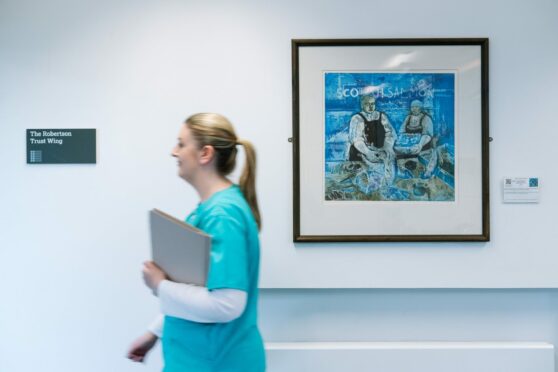
Art has the power to move, inspire, and, according to experts, heal as the walls of Scotland’s hospitals and care homes fill with paintings by some of Scotland’s most acclaimed artists.
For the past 30 years, Edinburgh-based charity Art in Healthcare has placed items from its extensive collection within medical settings, aiming to improve the sterile, scary, wards and consultation rooms that most of us will, reluctantly, visit throughout our lives.
Rather than simply filling a blank space or distracting the eye, each artwork, explains the charity’s executive director Vanessa Paynton, plays a different role to viewers.
“On a very basic level, yes, they are brightening up and improving quite a stressful, sterile environment,” she said. “But our artwork is also helping people to manage that stress, and provides points of stimulation for people who might find themselves in hospital for a long time.
“We’ve got lots of stories from people who, over the years, have been in touch to tell us that the artwork has made a real difference. Whether it has allowed them to calm down and just relax before an important appointment, or formed part of their rehabilitation, walking just a little bit further down the corridor every day to get to the next one, the artwork makes people react in different ways.
“One patient also said she was so fed up talking about her illness, almost being defined by it, that our artwork was an opportunity to simply talk about something else that was really quite joyful.”
The Art in Healthcare collection began in the early 1990s with just 100 paintings and now comprises more than 1,600 pieces by artists including Denis Peploe, John Bellany, Wilhelmina Barns-Graham and Eduardo Paolozzi to name but a few.
Founded by Matilda Hall, a lifelong collector and curator, the charity – then known as Paintings in Hospitals Scotland – began as an off-shoot of an established charity in England, but quickly found its footing north of the border.
“I went to London where I met the board members of Paintings in Hospitals,” explained Hall, now in her 80s, of the early days of the charity. “They had very generously given me the loan of paintings and then asked, ‘So, how much will it take to start up in Scotland?’
“I said, well, about £10,000 – and a cheque for that amount was made out there and then and passed down the table. That only happens once in a lifetime!”
Hall began placing 10 paintings at a time in hospitals for a small fee (“I worked out a sort of Jeremy Paxman phrase; ‘here’s your starter for 10’”, she explained with a laugh) and interested partners “grew exponentially” as news of their impact spread.
Hall added: “My job, as I saw it, was to get the pictures into hospitals to cheer up gloomy walls. There’s quite a body of work that indicates that people do recover quickly if they are surrounded by works of art, too. Now, we have pictures from Orkney to Dumfries and Galloway.”
The curators work closely with staff, patients and long-term residents to ensure each painting finds its rightful home – something which Paynton believes is essential for making art more impactful, more accessible. “Nobody is ready to go to hospital, but we all find ourselves there at some point,” said Paynton.
“So, it’s exciting to be able to place artwork in settings where people don’t necessarily expect to see it – they haven’t asked to see it, and it’s not like going into a museum or a gallery. I think that’s part of its power.
“For us, making quality art democratic feels very important, and a great way of doing that is to put it into these spaces that actually have very large footfalls and very diverse communities.”
Now, with the pandemic providing the charity an opportunity to review its collection, pausing new acquisitions so it can “take stock and understand what we have and how it can be used”, Paynton says there will be an increased emphasis on providing not just artwork rental, but also hands-on workshops in community and care environments, too.
However, no matter how large the collection grows, how varied the artists, Paynton says there will always be one goal.
Paynton said: “One of our organisation’s key values is care – through our outreach, we care about people, we care about our collection, and we care about environments.”

Enjoy the convenience of having The Sunday Post delivered as a digital ePaper straight to your smartphone, tablet or computer.
Subscribe for only £5.49 a month and enjoy all the benefits of the printed paper as a digital replica.
Subscribe